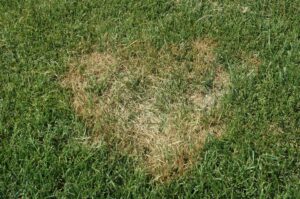Table of Contents
ToggleLast Updated on April 18, 2025
What is Brown Patch Disease?
Brown patch disease is a very destructive summer lawn disease that causes damage to lawns in the New Jersey area annually. Typically, this disease infects perennial ryegrass, tall fescue, bentgrass, and Kentucky bluegrass varieties of turf grasses. Although this disease is destructive, there are brown patch treatments that will help stop the spreading of the disease
 Signs and symptoms
Signs and symptoms
In the early morning hours when the lawn is wet from dew you will notice white spider web like structures on the surface of the turf. This is called mycelium, which is the growth of the fungus. The turf in the surrounding area will look sunken-in and have a “smoke ring” pattern. On the individual blades of grass, lesions can be seen clearly and appear as tan or light brown spots surrounded by a dark brown border, which creates the look of brown spots in your lawn during the summer.
Conditions
This disease lives in the thatch and soil, and can live there for many years even without desirable grass types to infect. Brown patch is prevalent when surface moisture and humidity are high with nighttime temperatures above 68 degrees and daytime temperatures at 80 degrees or above. Rainy weather and high humidity will accelerate the severity of this disease. This disease can form and spread almost overnight; luckily with brown patch treatments you can control the disease.
Treatment
When brown patch disease is active and the environmental conditions are favorable, spreading of the disease continues. We recommend that a fungicide be applied to the lawn for brown patch treatment; a fungicide is meant to stop the further spreading of the disease to uninfected areas of the lawn. A fungicide will give about 20-30 days of control depending on site conditions. This gives the lawn some time to grow out the disease without it spreading further and for the infected blades of the turf to recover. If the environmental conditions remain favorable after the 20-30 day period, another fungicide may need to be applied to continue control of the disease. Preventative treatments are possible but need to be applied monthly throughout the summer.
Cultural practices
The best way to prevent or reduce the spreading of brown patch disease in a lawn is to follow good cultural practices.
Water properly. Avoid light, frequent irrigation in the early morning while surface moisture is present. Deep, infrequent watering that occurs between 12 am – 6 am is the best way to water a lawn properly. Underground irrigation systems should be run 1 – 1 ½ hours per zone every third or fourth day and hose-end sprinklers should be run 3 – 4 hours per zone once per week. The goal is to get 1 inch of water on the lawn per week regardless of what type of watering application is used.
Proper mowing. Do not mow in the early morning when the lawn is still wet from dew or watering because this spreads the disease further. Mow the lawn when the surface moisture has evaporated. Keep the lawn height at 3 – 3 ½ inches in length. Mow off only the top third of the grass plant at a time. Mowing lower than the recommended height increases stress on the plant and can increase the severity of the disease. Also, we recommend removing the grass clippings after mowing until the disease is grown out, because this will help reduce further spreading. Rinse off lawn equipment after each use and keep your mower blades sharp. Dull mower blades can rip or shred the grass blades which will cause the grass to weaken and be more susceptible to disease.
Regular fertilization. Having a regular fertilization program will help the grass be strong and healthy. During the summer months it is best to avoid high amounts of nitrogen. Small amounts of nitrogen are okay in the summer to help regulate color and growth of the lawn.
Core aeration. Reduce the thatch layer and soil compaction by having the lawn core aerated regularly, at a minimum of every other year. Thatch (where disease harbors) is a loose organic layer of dead and living shoots, stems and roots that develop between the root zone of the grass blades and the soil surface. Ideally, this layer should be no more than 1/2 inch in thickness. Excessive thatch can be removed mechanically by core aeration or dethatching. The core aeration process has other benefits as well, such as providing a deeper, stronger root system and better movement of water, air and nutrients into the soil.
Conclusion
Brown patch disease can be very destructive if left unchecked. Being vigilant with good cultural practices helps to prevent or reduce the effects of this disease on your lawn. If all else fails a fungicide should be applied to defend your lawn until the environmental conditions improve. With the brown patch treatments described above, the spreading of the disease can be lessened or controlled.
If you have brown patch in your lawn and are in our service area, feel free to contact us at 908-281-7888 or visit our website at www.fairwaygreeninc.com for a free estimate to go over potential brown patch treatments.

